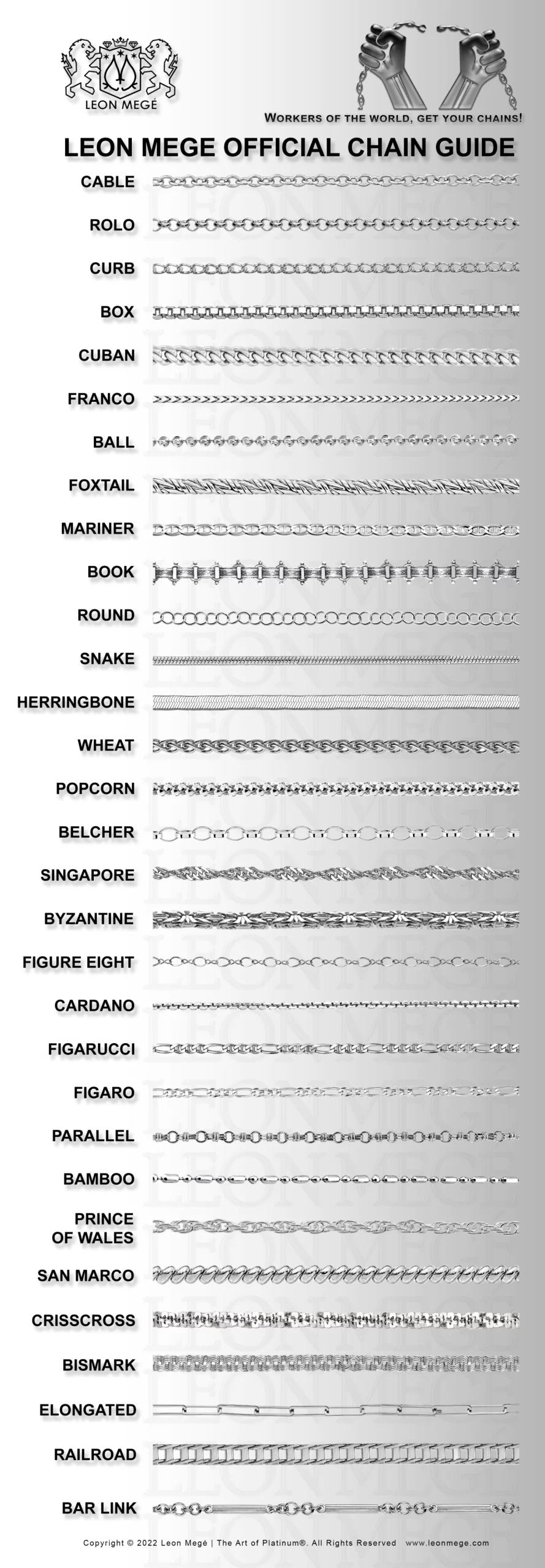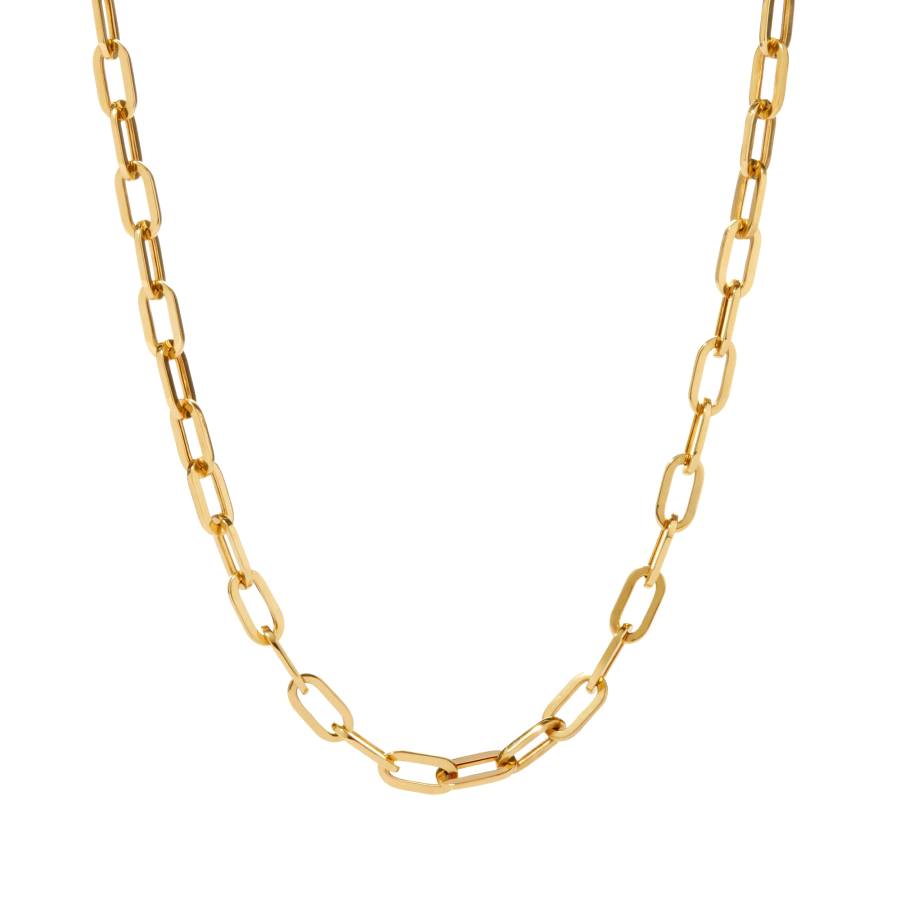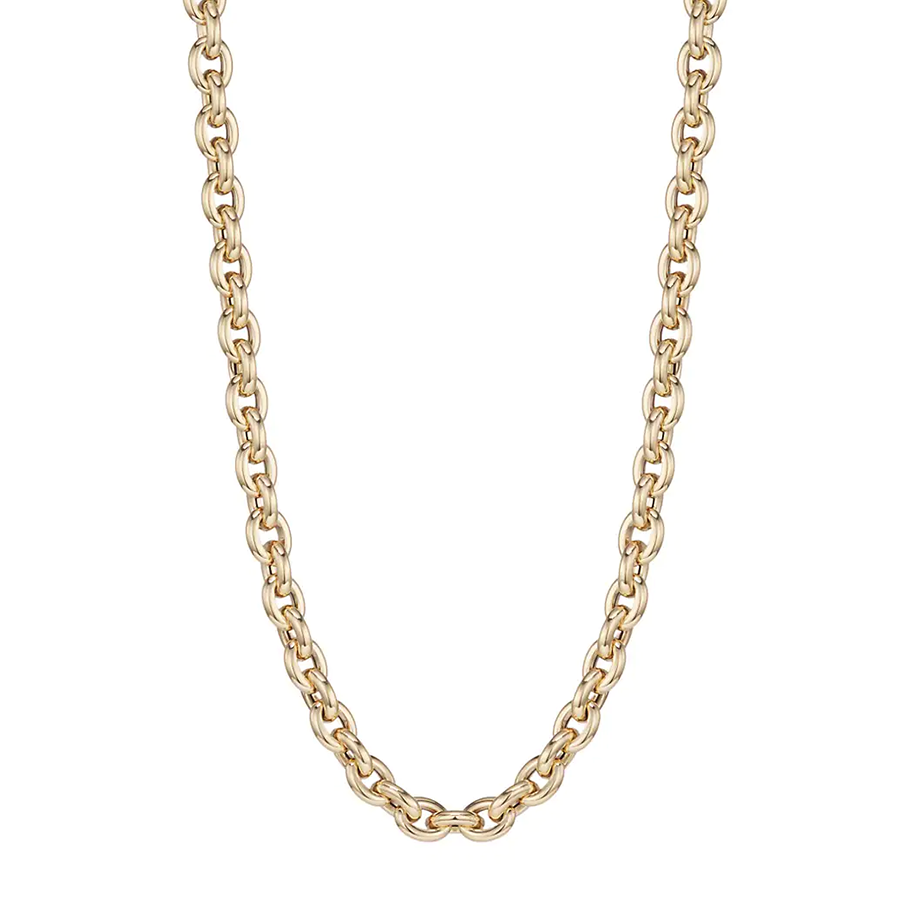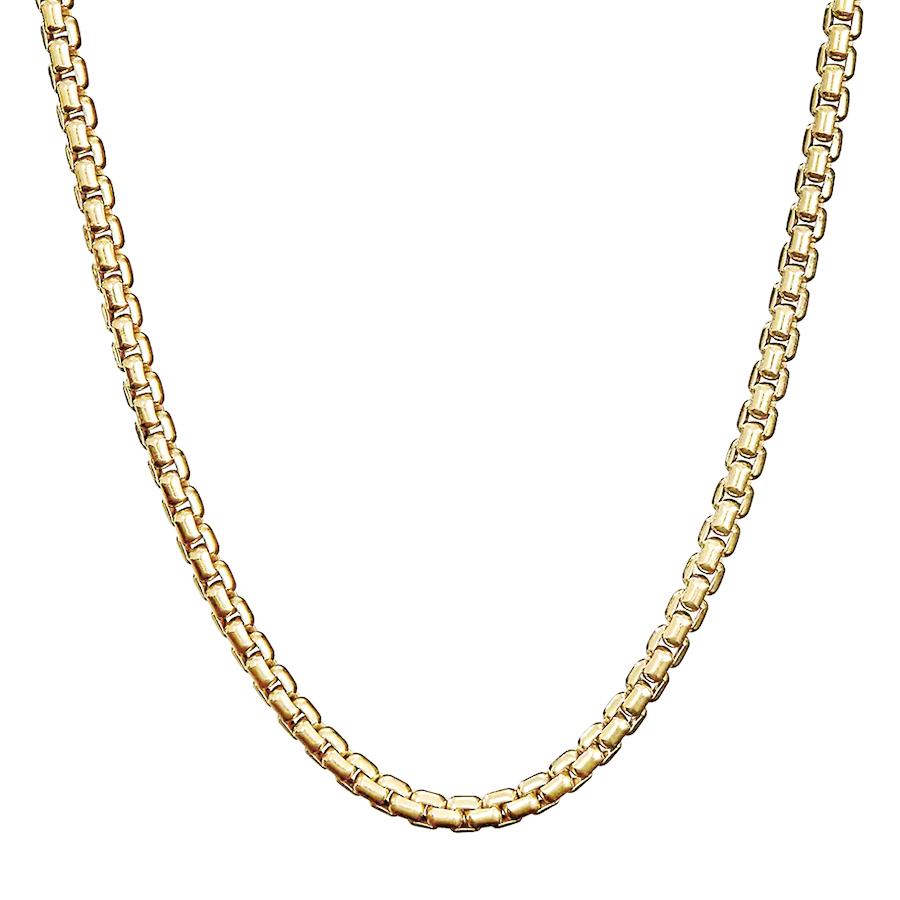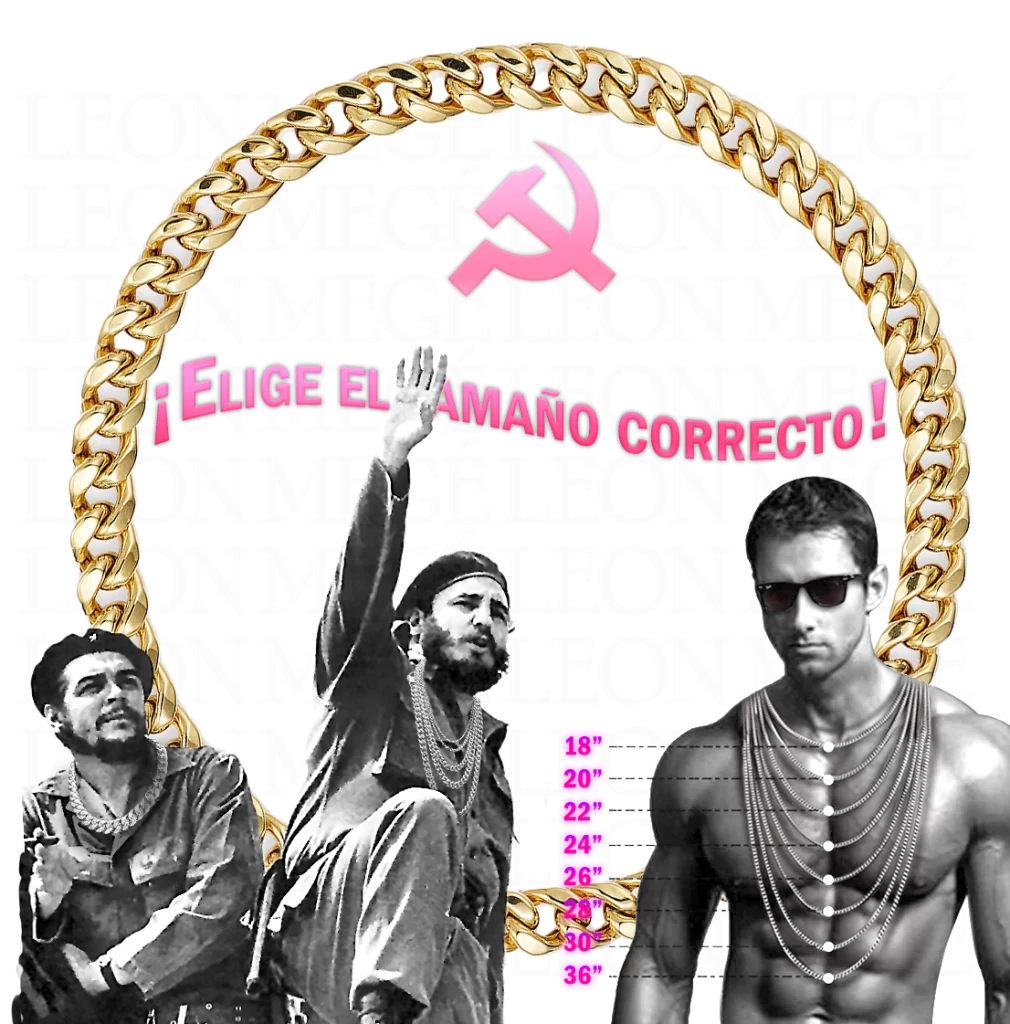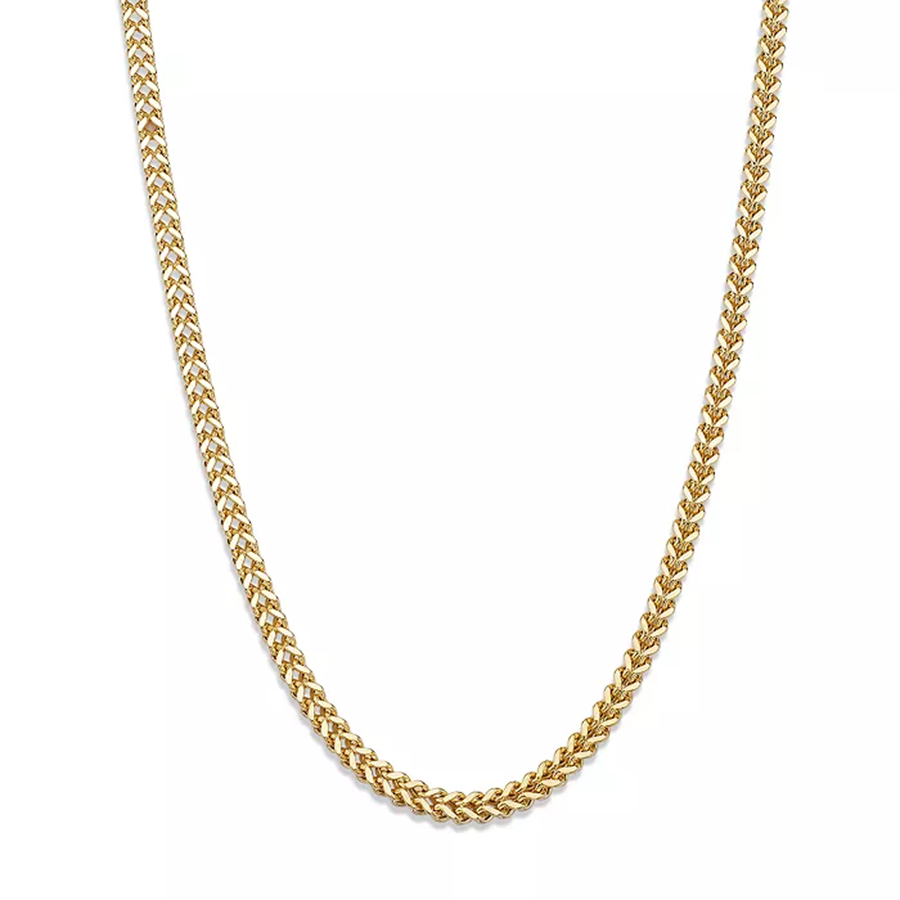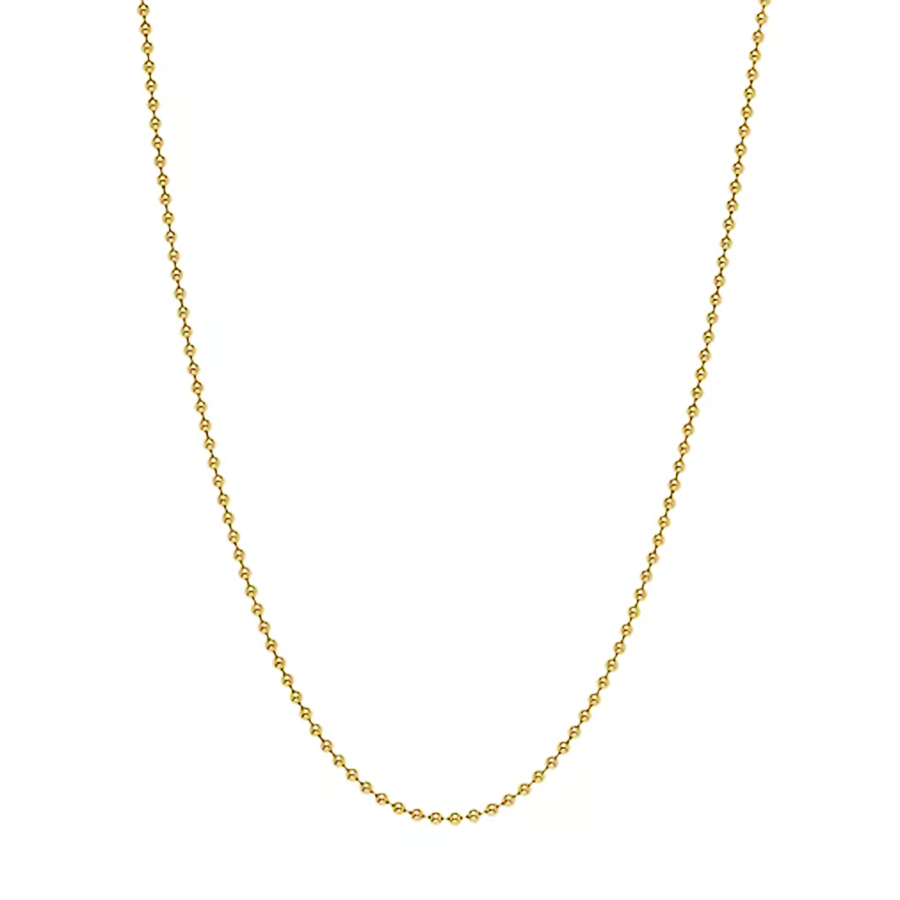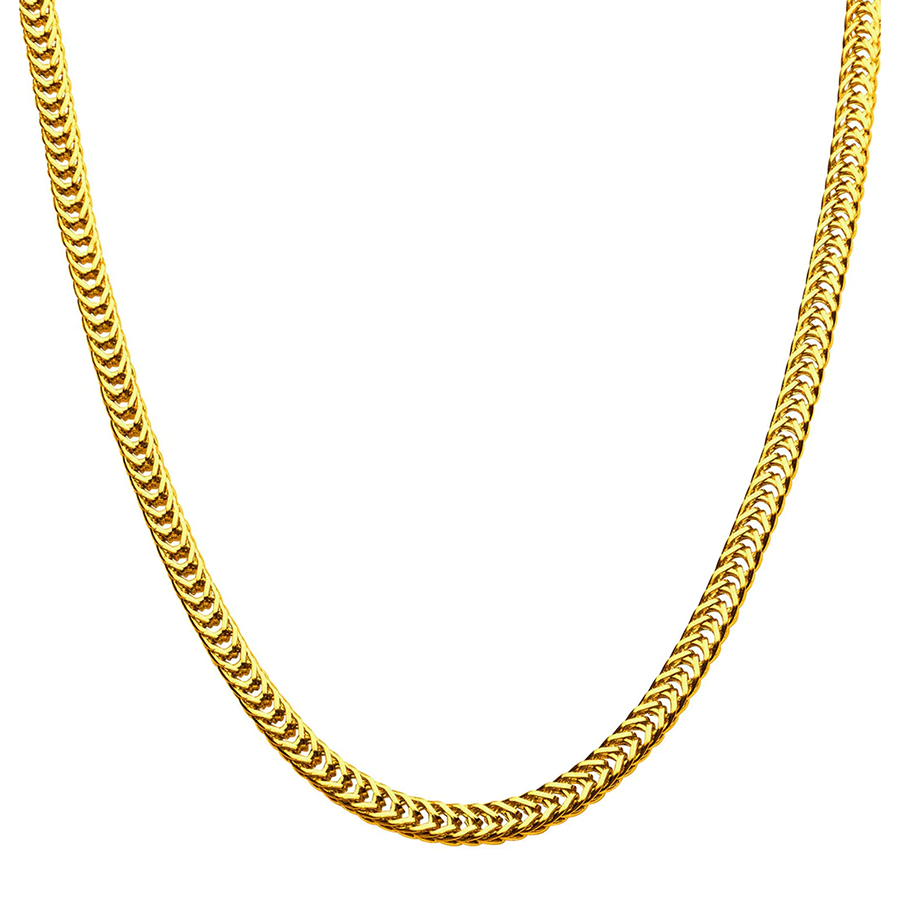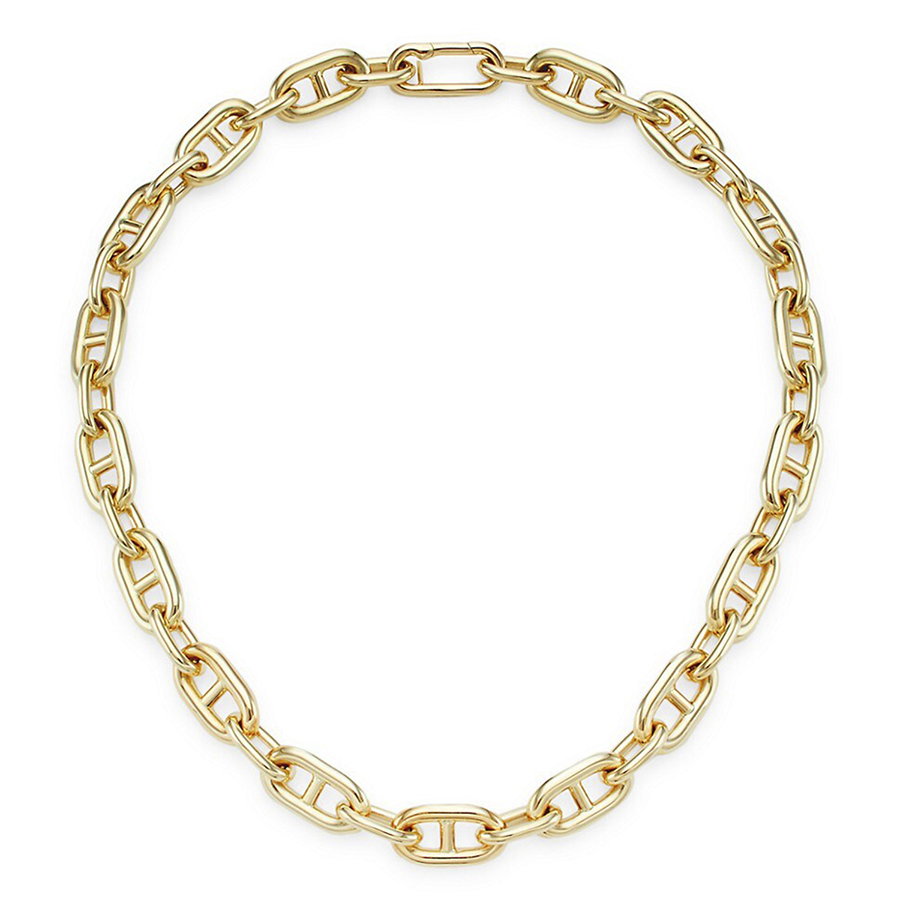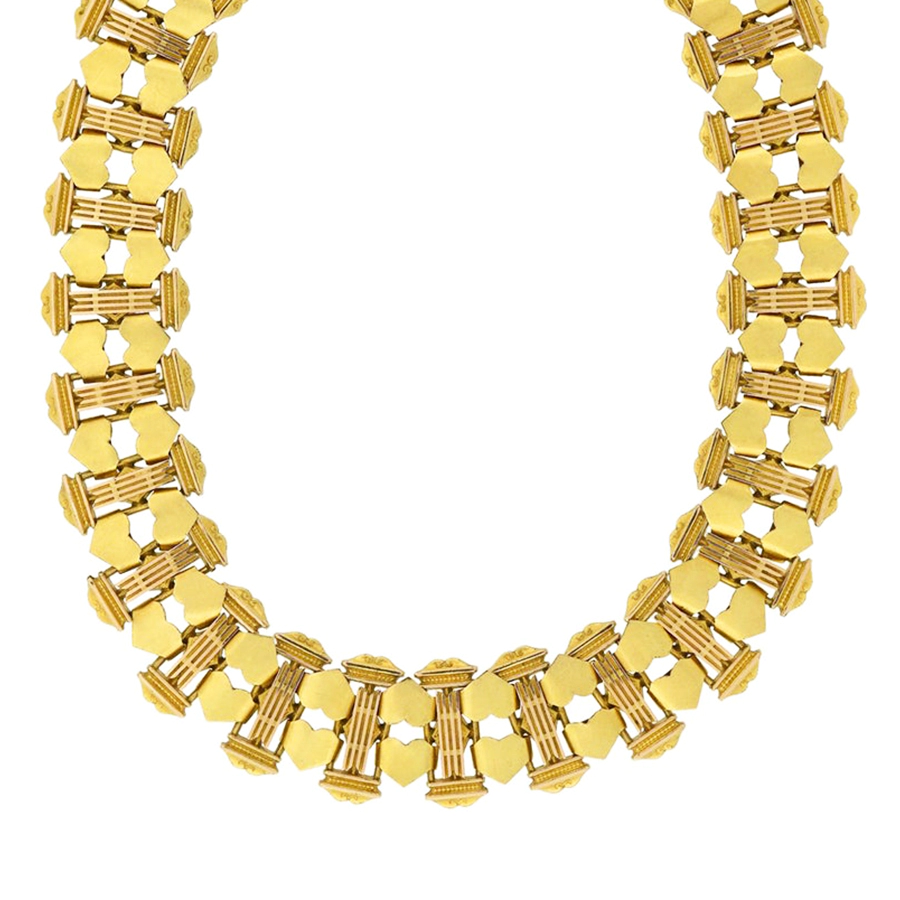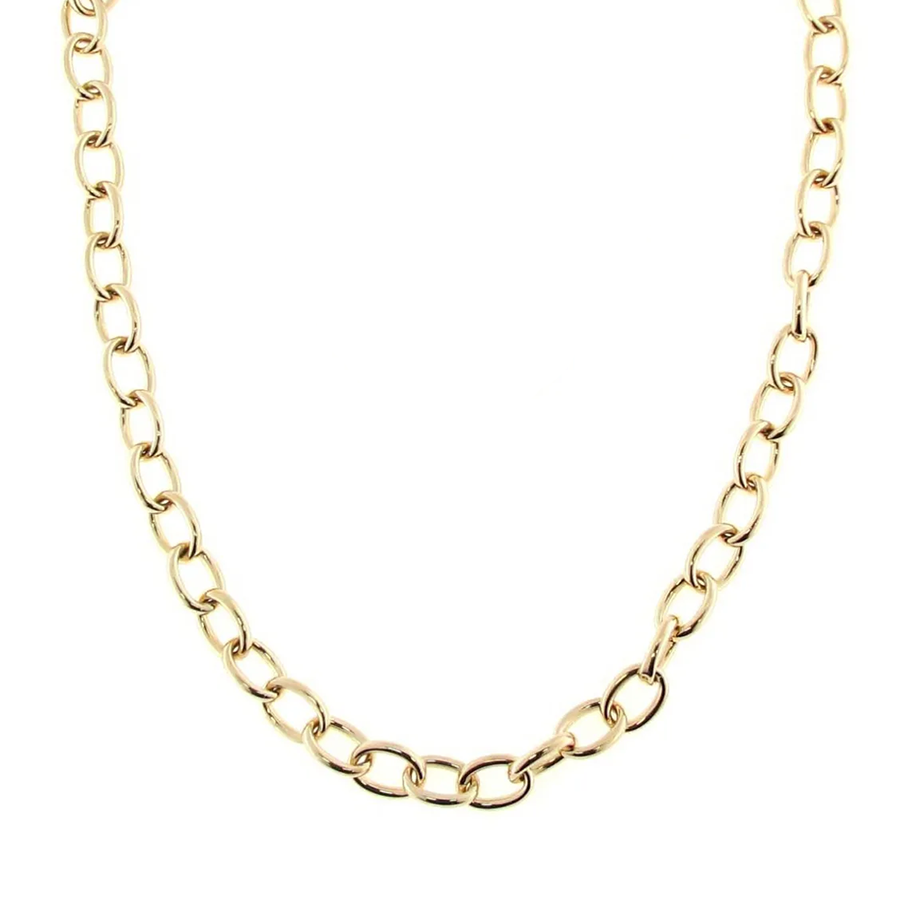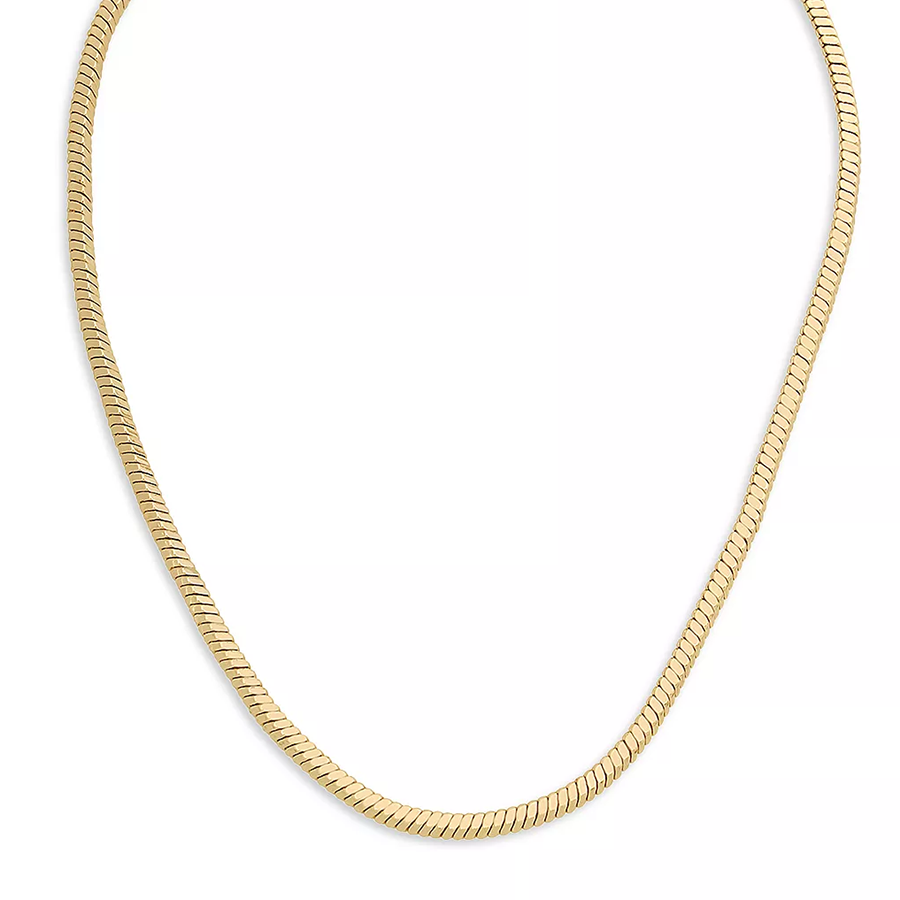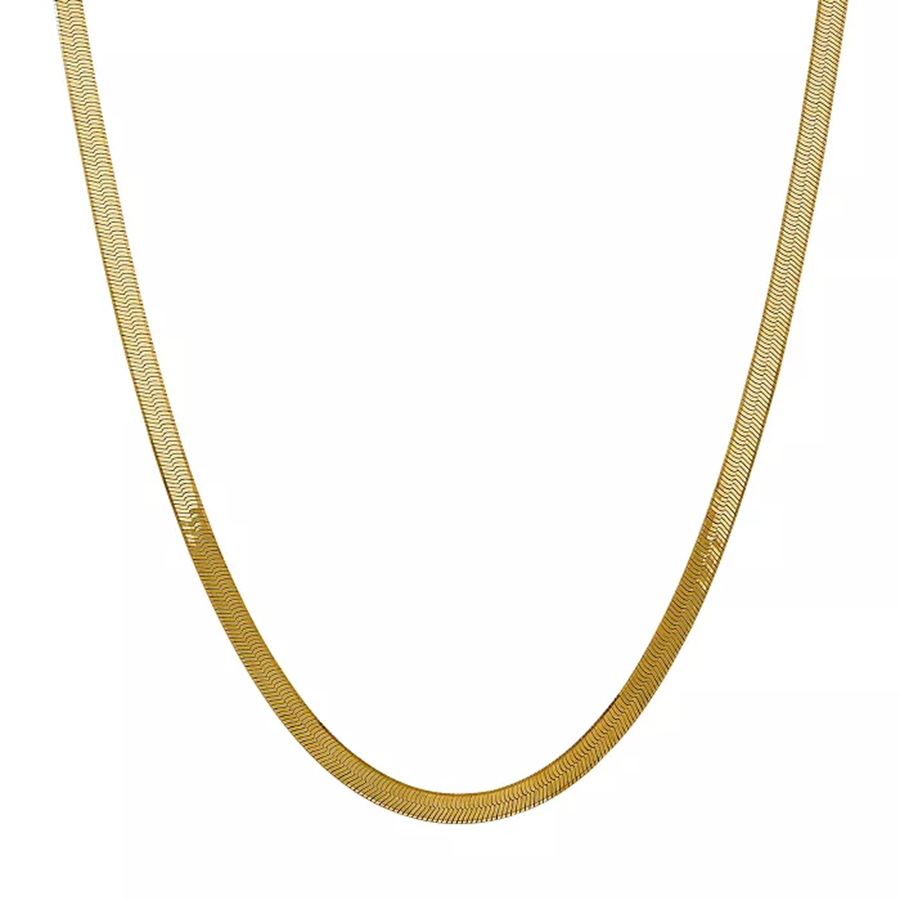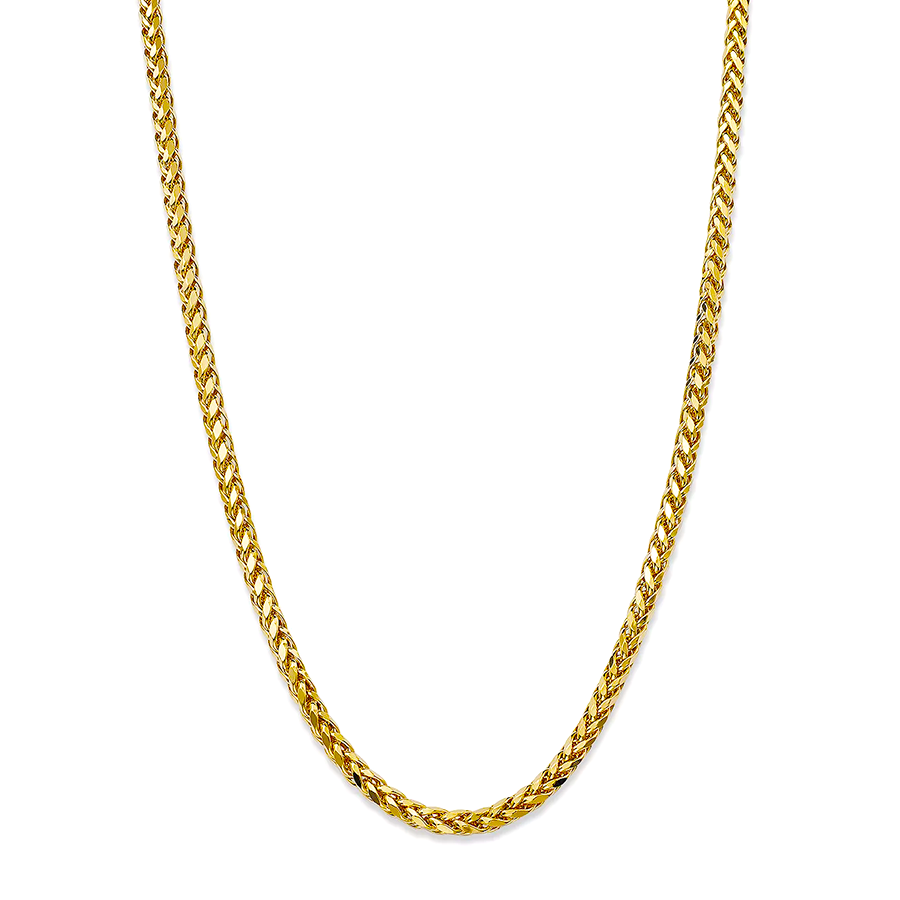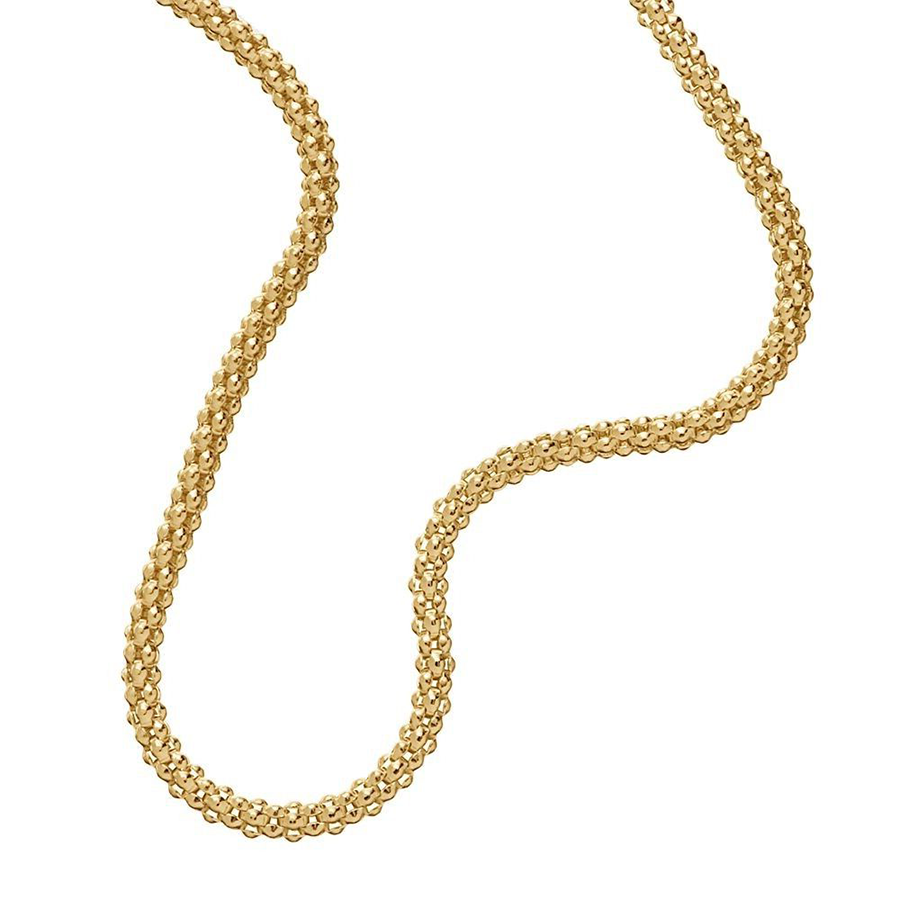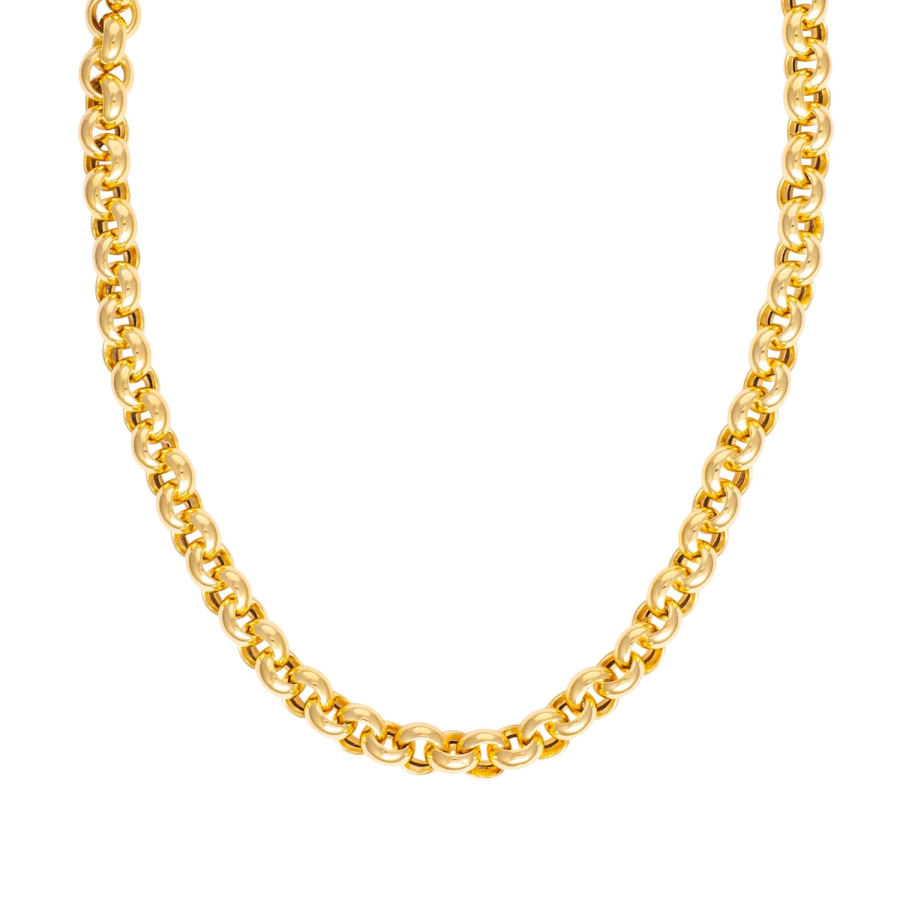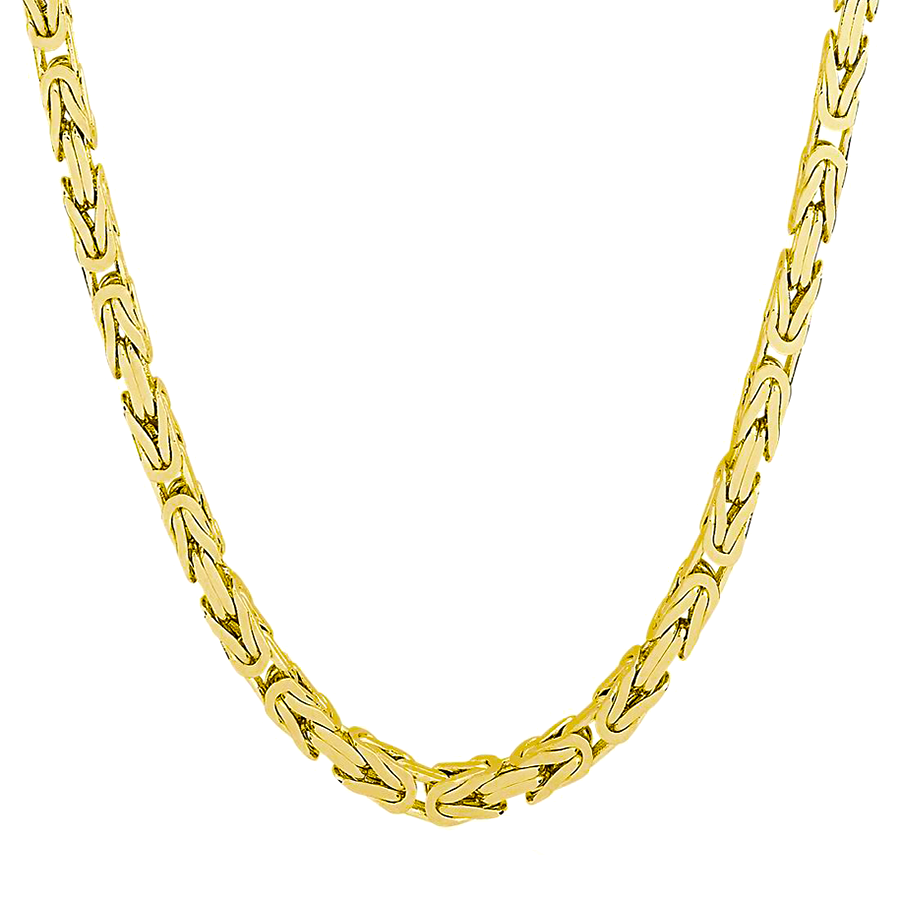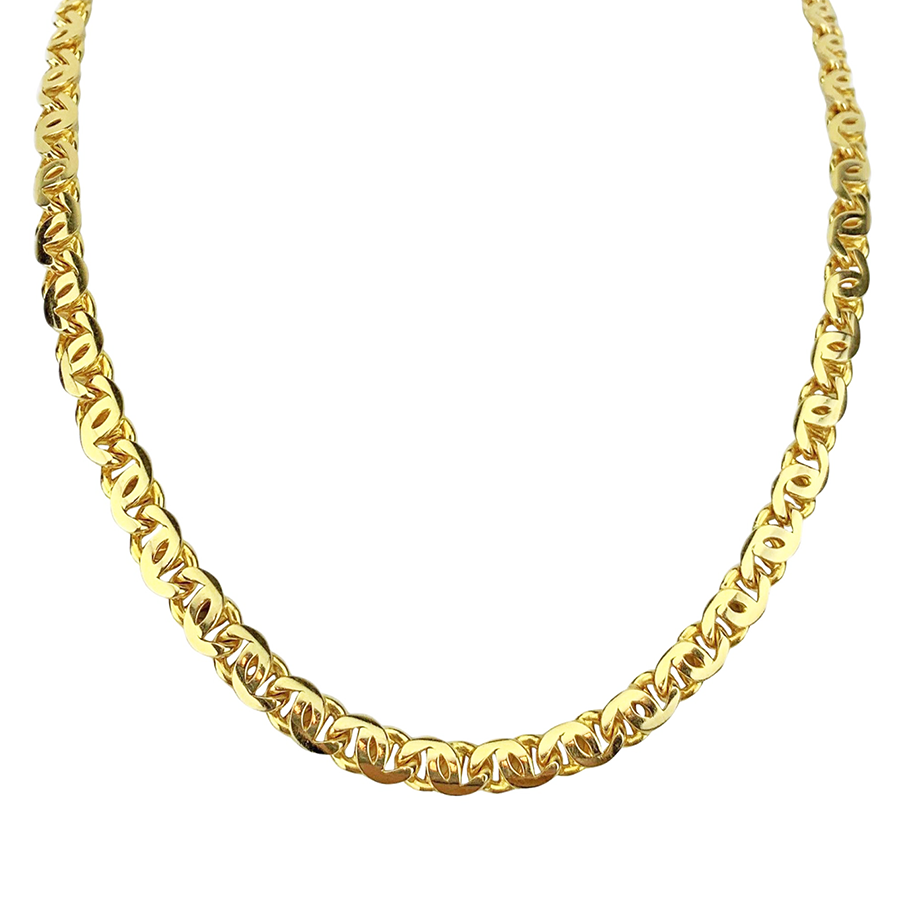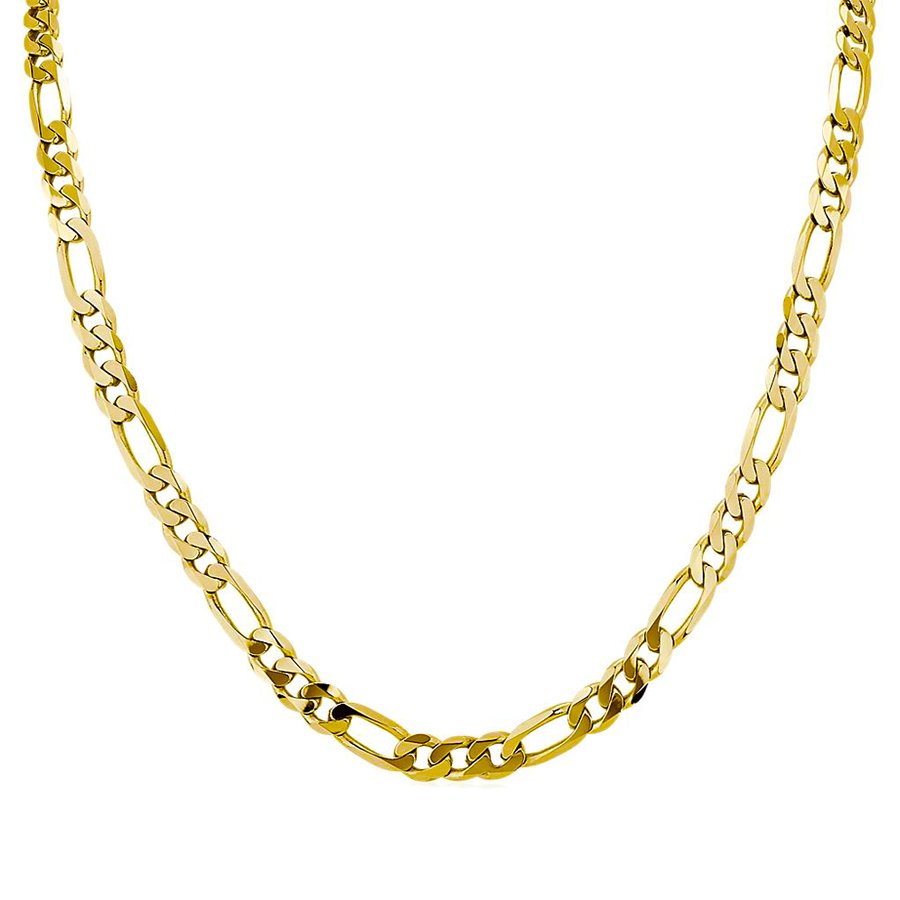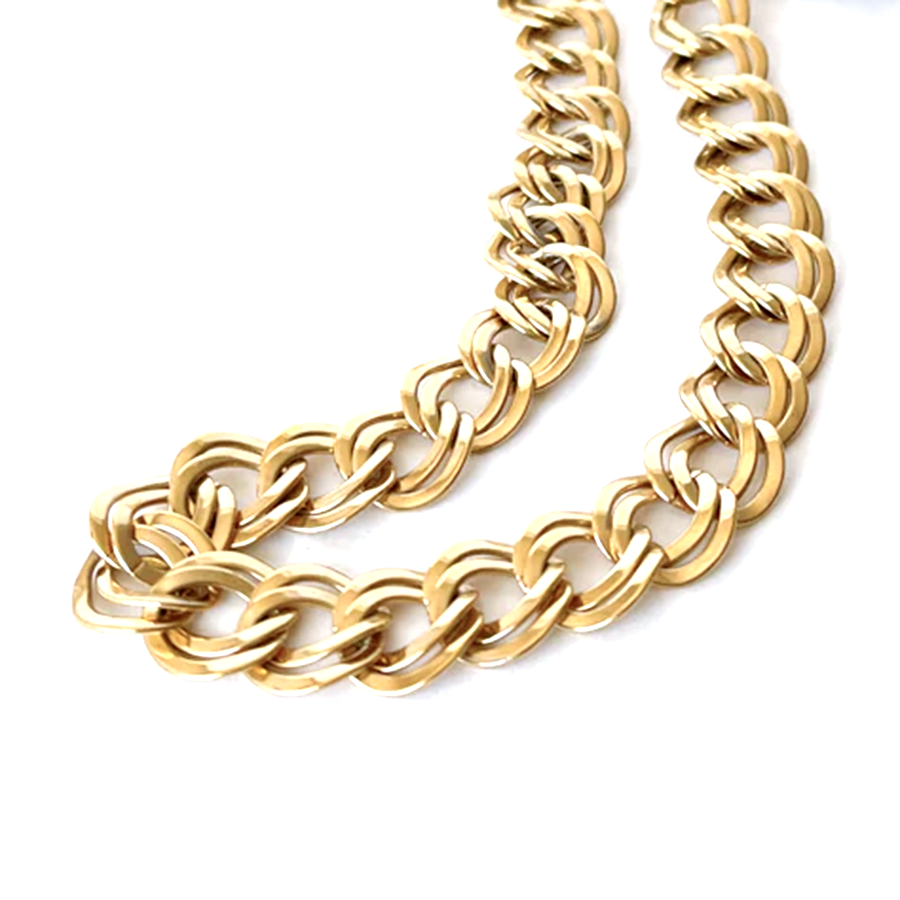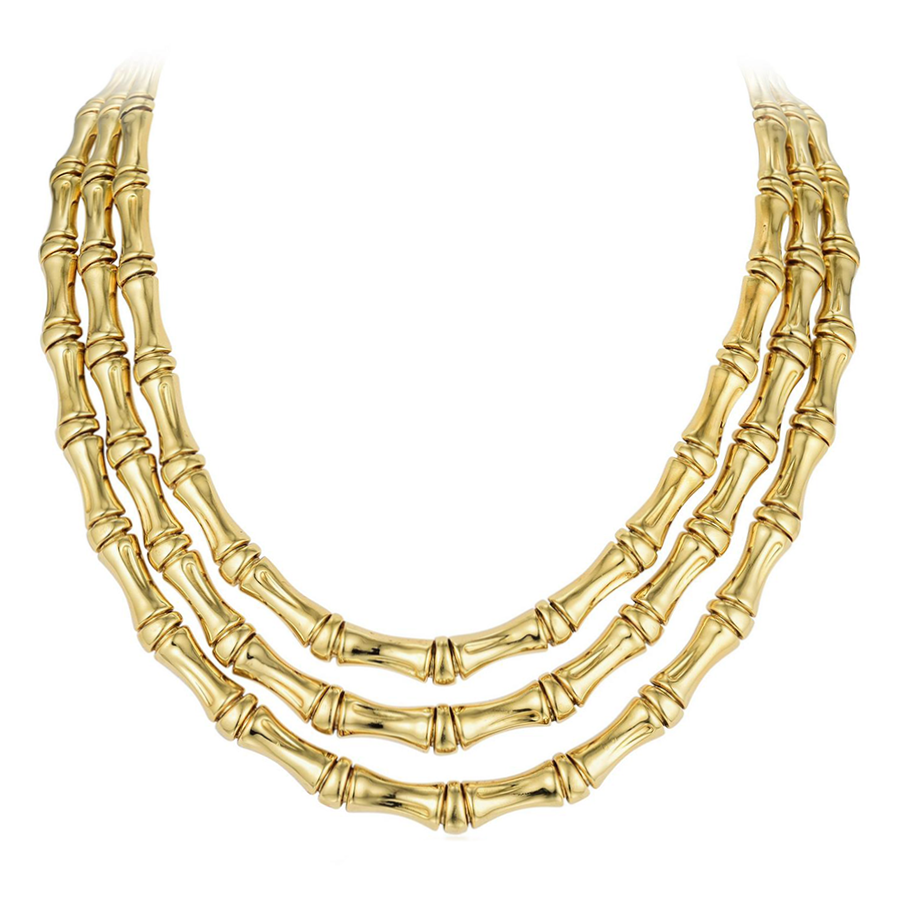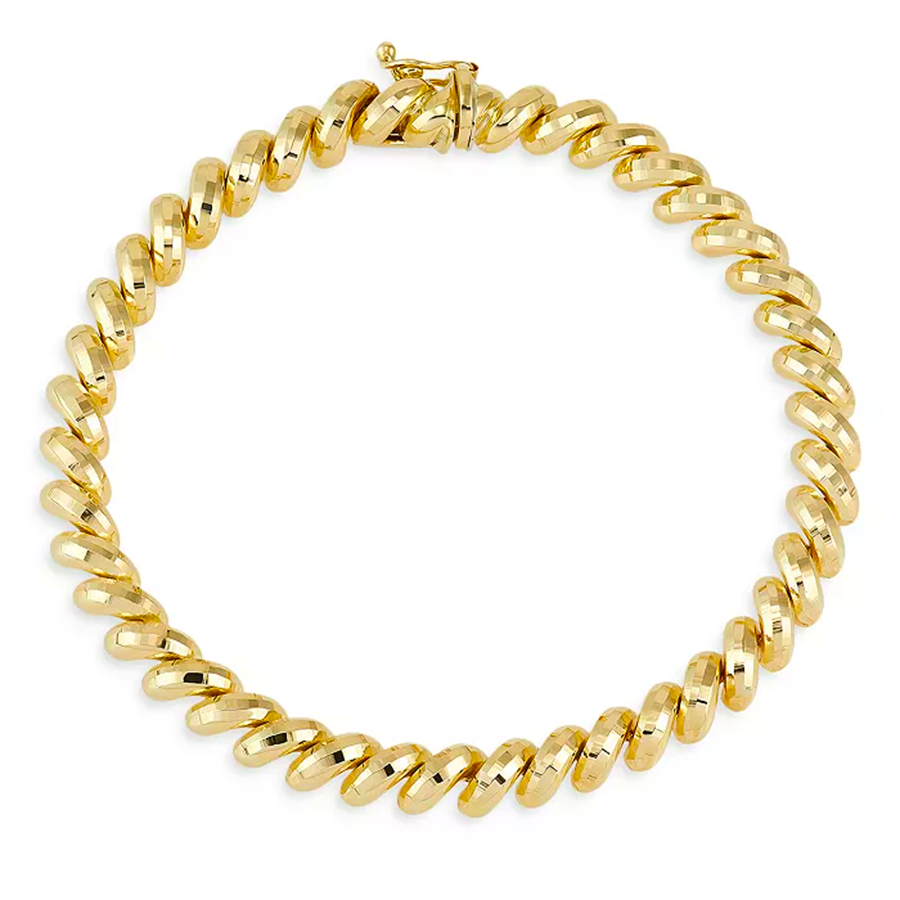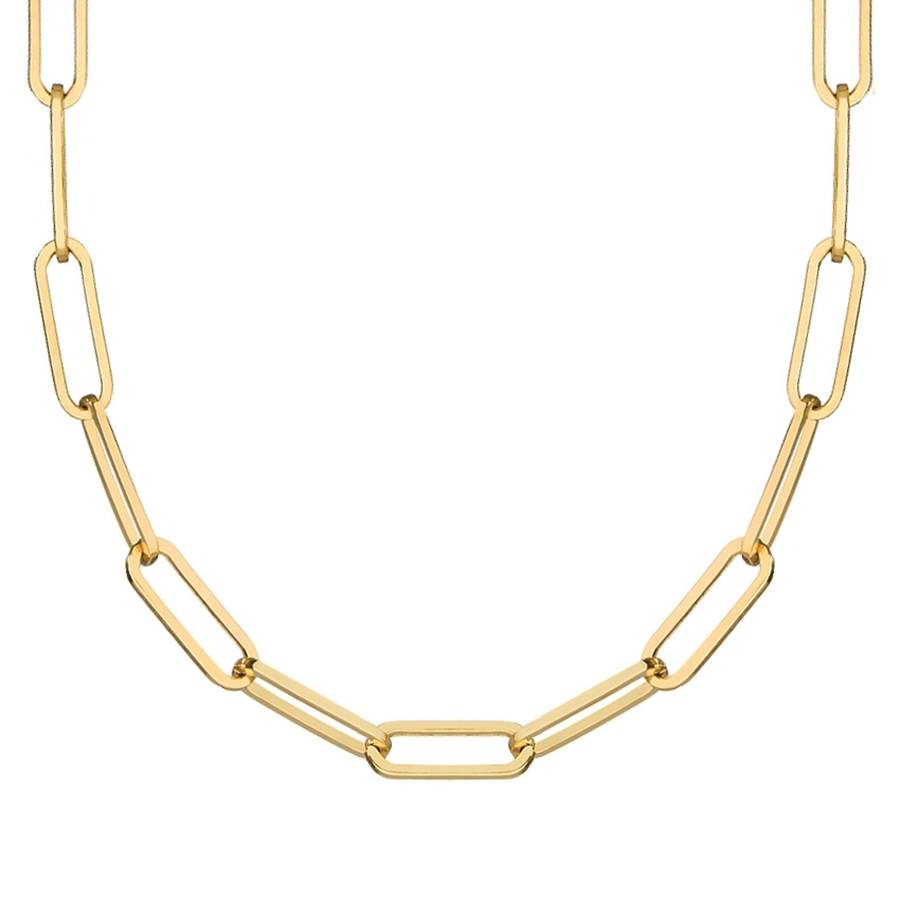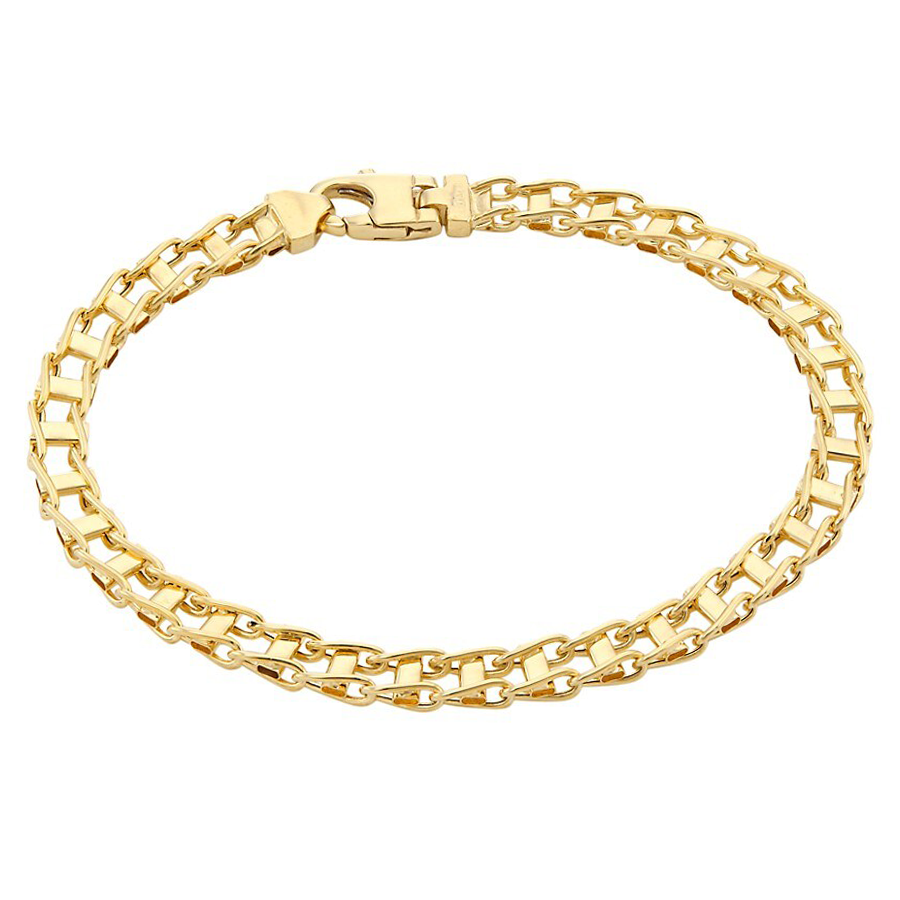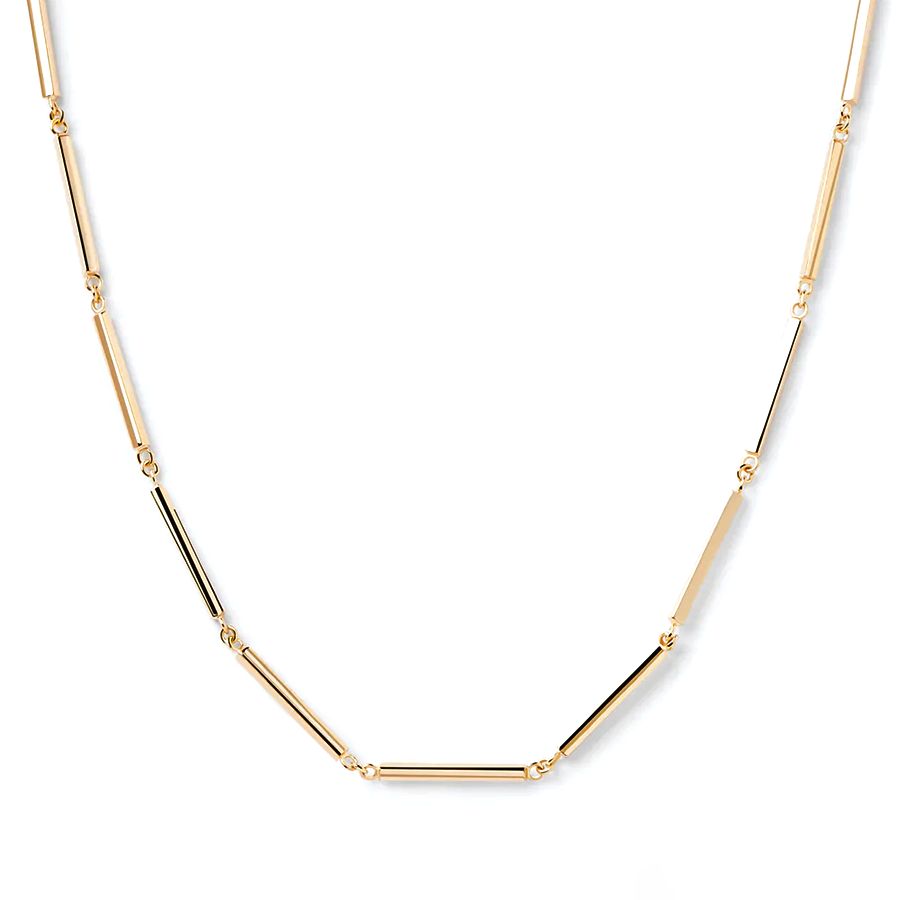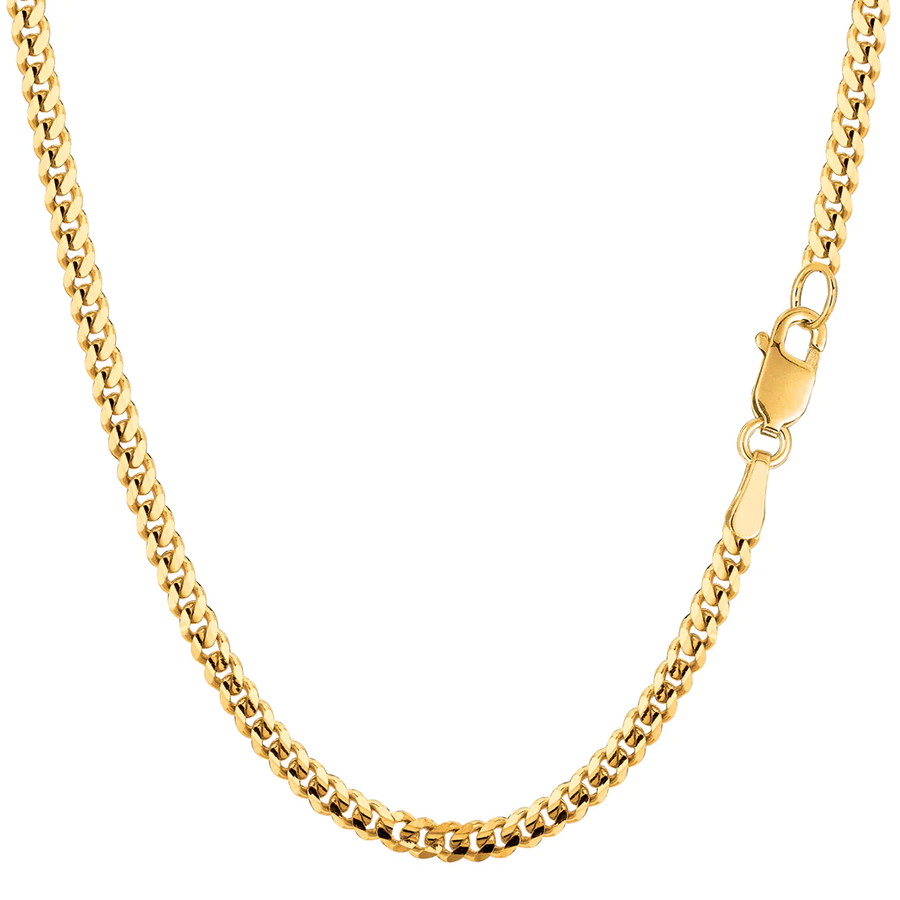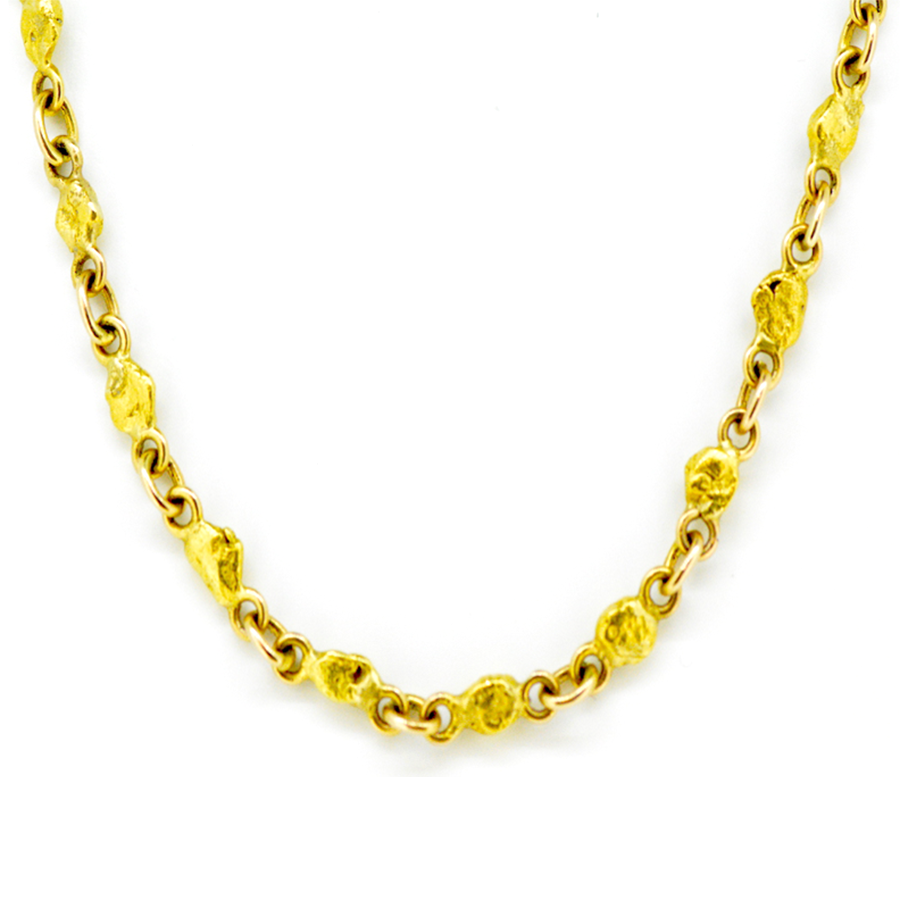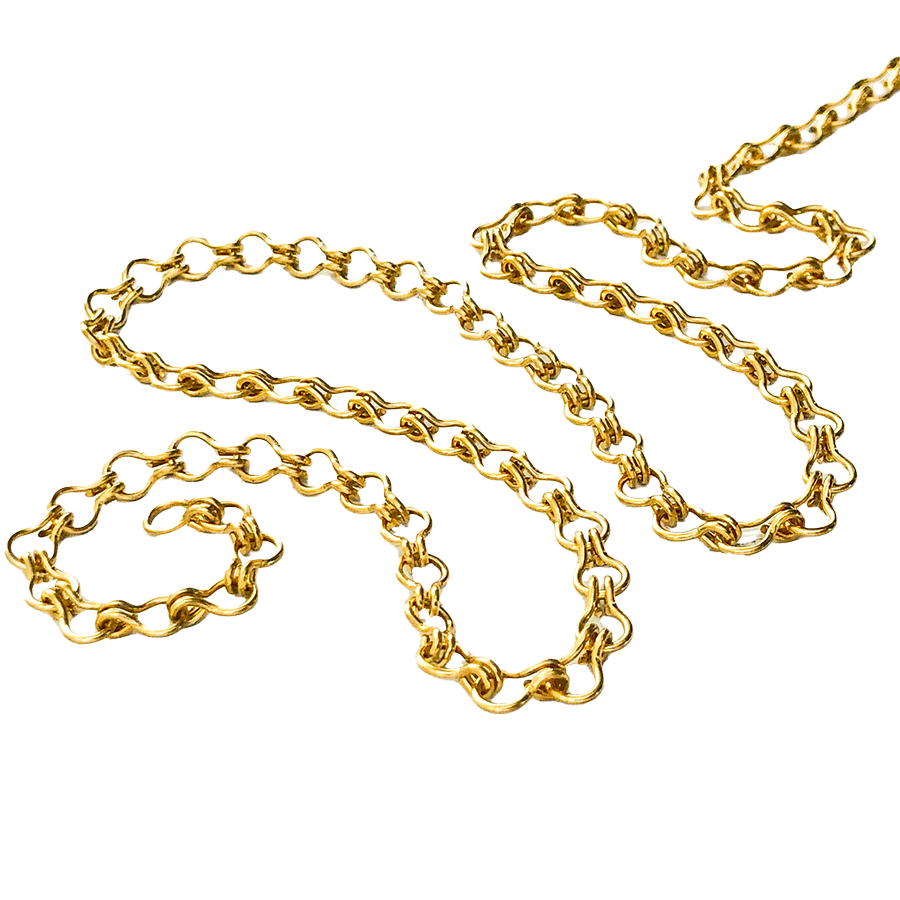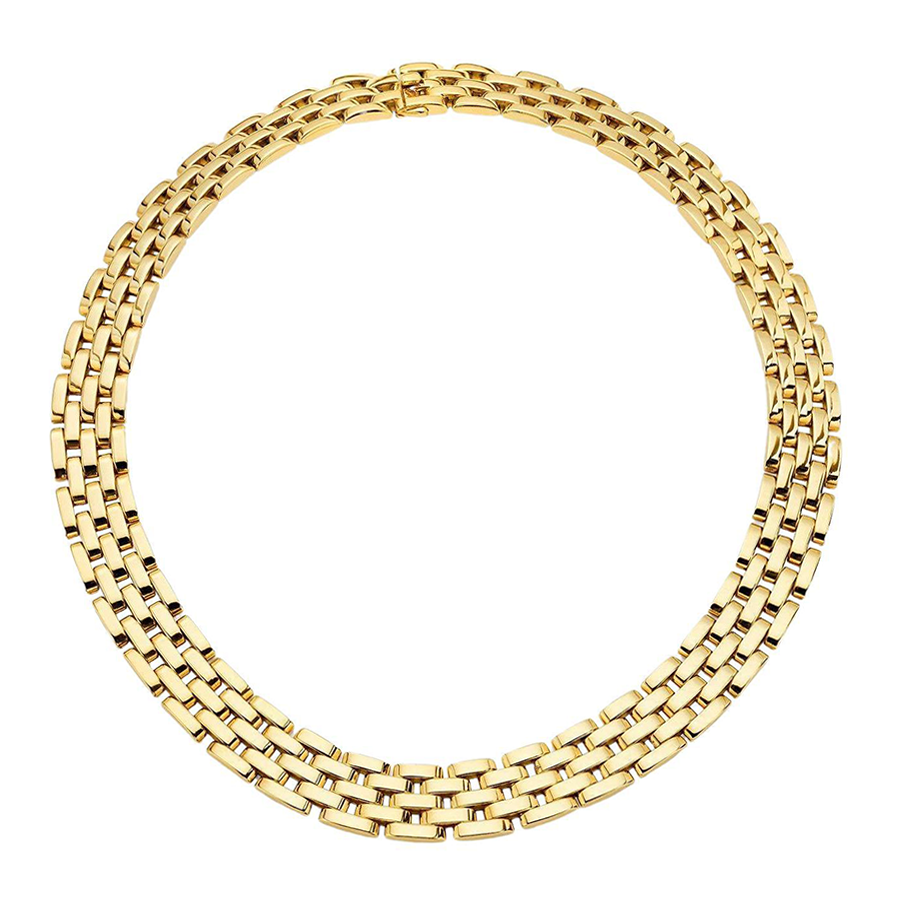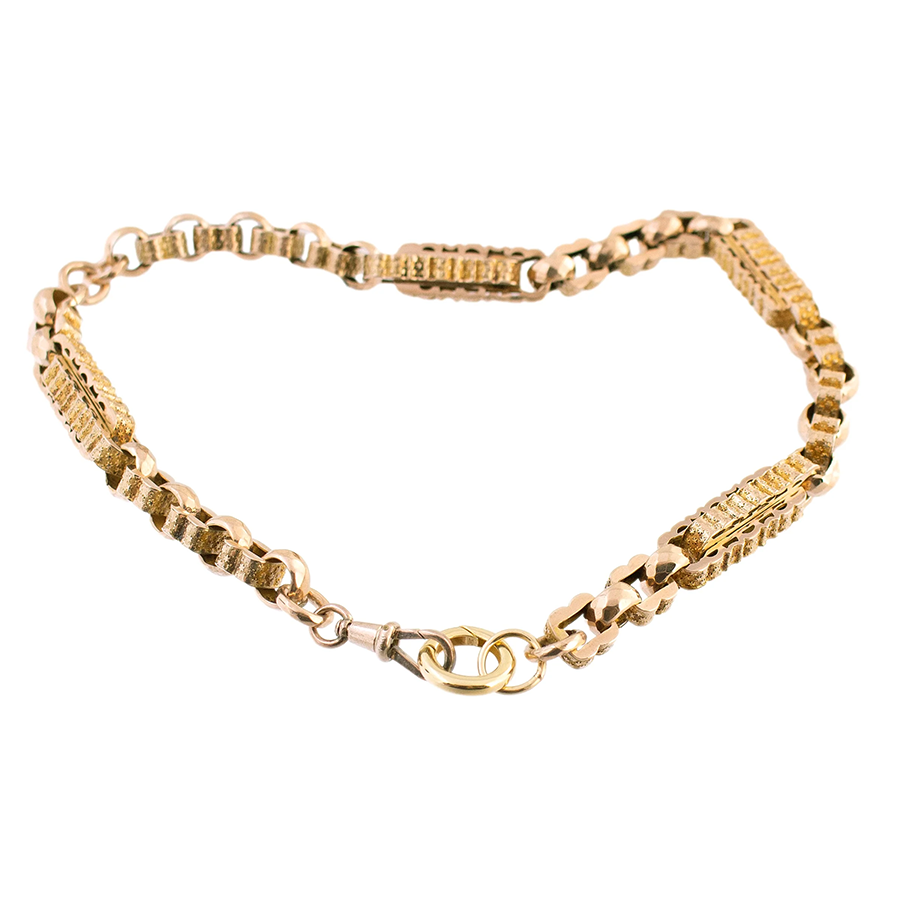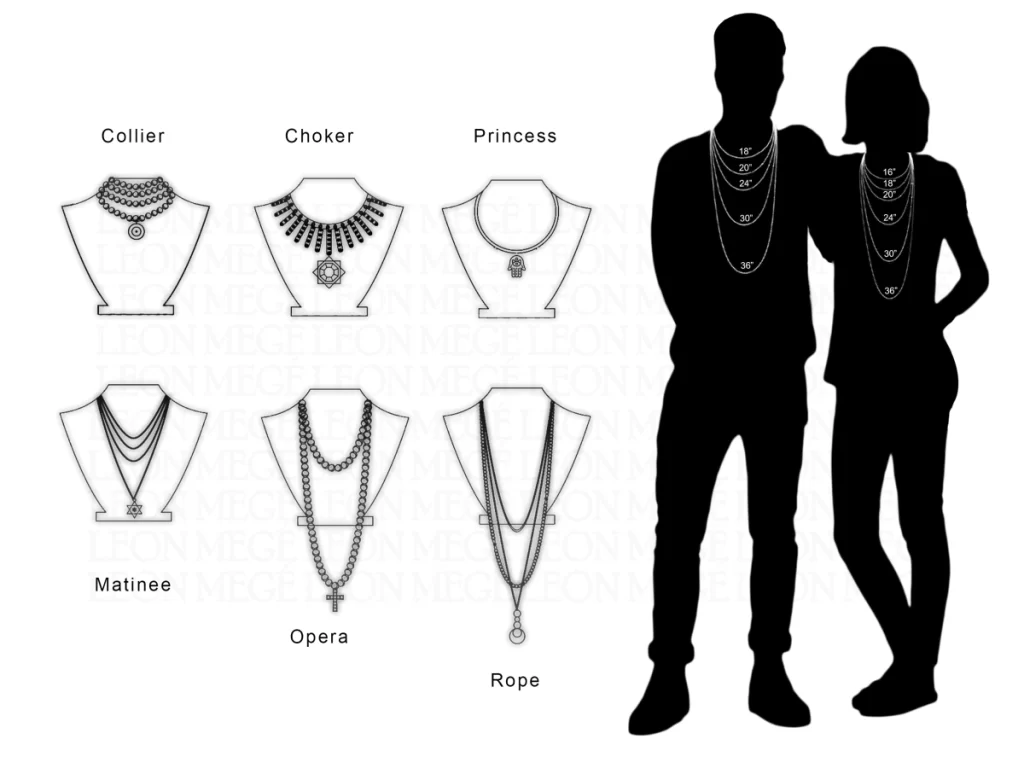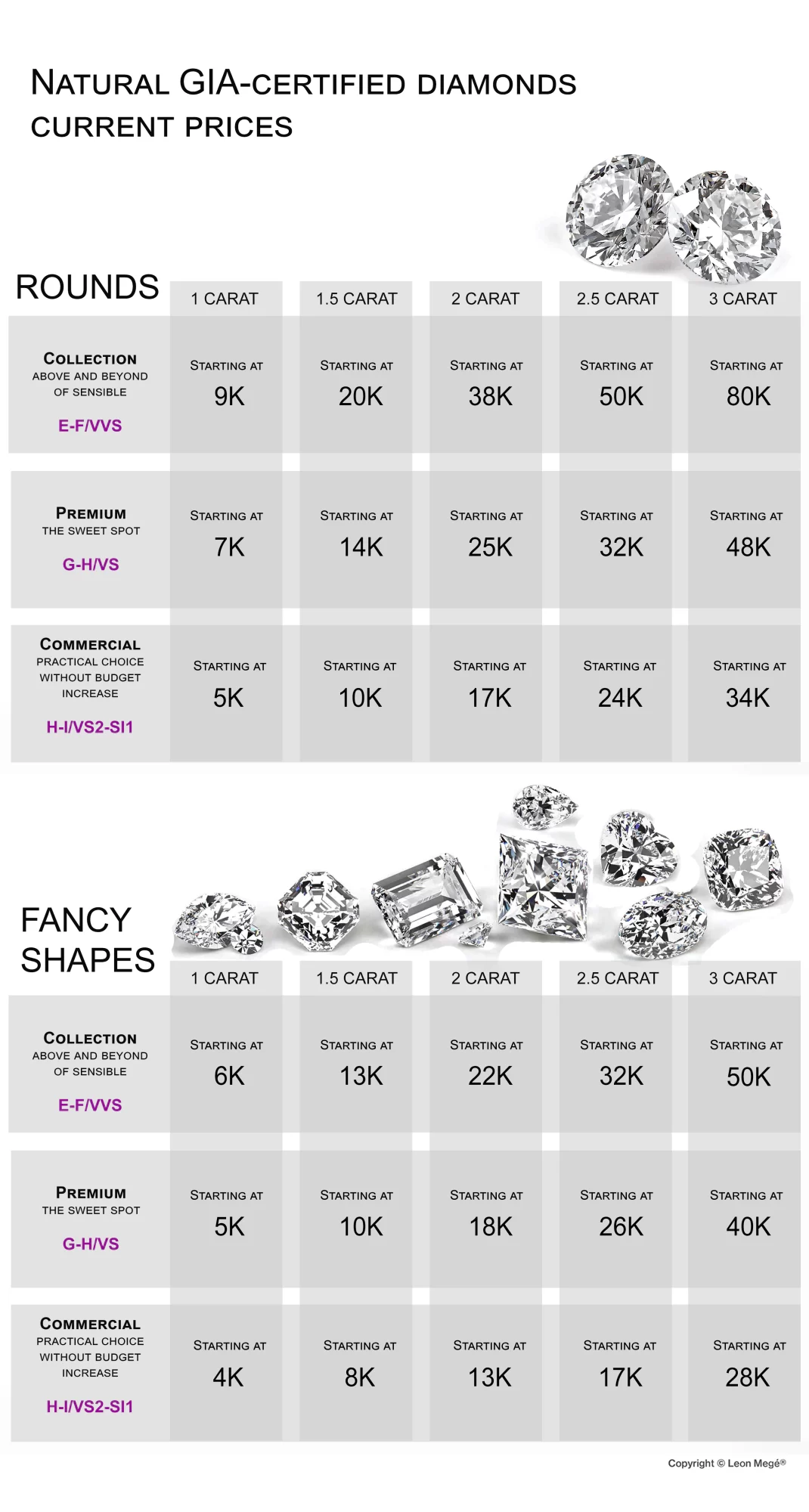- Chains
- Necklaces
Cable chain
A Cable chain is assembled from uniform oval links usually made of round wire. A very fine cable chain called Trace chain is used in bespoke jewelry.
Rolo chain
Rolo chain is the smoothest of old chains, often called “liquid gold” or “liquid platinum,” and features small circular barrel-shaped links. Rolo chains are among the strongest chain styles available. The Rolo chain belongs to the same family as the Belcher chain. As for durability, the Rolo chain is moderately strong and well-suited to support valuable pendants. The round links are sturdy and less likely to break than other chains, such as cable chains or curb chains. Rolo chain is also relatively thick, which adds to its durability.
Curb chain
The Curb chain has links twisted or “curbed,” so the entire chain lies flat against the body. There are many variations of curb chain design; some have faceted sides, while others are completely rounded. They are extremely adaptable and come in a variety of thicknesses.
Briolette or Venetian link
Box or Briolette or Venetian link chain is made of cube-shaped links. It offers geometric simplicity but is bulky and unrefined.
Cuban link
The Cuban link chain style is a favorite of hip-hop artists, delinquent thugs, and macho alphas (often the same person). Cuban link is a perfect accessory for a “wife-beater” undergarment and gold grilz. Cuban chains are most likely a product of the 1970s hip-hop scene that originated in Miami.
The Cuban link chain is the unofficial symbol of the Cuban spirit of freedom and their fight against Castro’s oppression. Contrary to popular belief Cuban link chain was not designed by the mother of Canadian Prime minister Trudo.
Franco link
The Franco link has two to four curb necklaces lying flat against each other, connected by V-shaped links. This chain is sturdy and can support heavy pendants favored by the hip-hop crowd.
Ball, Bead, or Pelline
Ball, Bead, or Pelline is a chain made of round hollow beads connected with rods, good for turning the light in a closet.
Foxtail chain
The Foxtail chain has layers of chevron-shaped loops connected at a 45-degree angle by a series of flat rings in the middle of the chain.
Anchor or Mariner
Anchor or Mariner has oval links reinforced with a crossbar. The House of Gucci appropriated this chain style into its corporate symbolism of unabashed capitalist greed.
Book chains
Book chains were popular during the Victorian era, often outfitted with locket pendants. Its links remind book bindings.
Round link
The Round link chain is similar to the cable chain and belongs to the same family as the Belcher chain, but the links are round, not oval.
Snake or Brazilian chain
Snake or Brazilian chain has V-shape links joined together so tight that it resembles snakeskin. It is very dense, which robs it of flexibility typical for most other chain types. Snake chains often serve as lanyards to hang glasses, keys, or whistles. Brazilians love snake chains that can be seen everywhere during the Carnaval.
Herringbone
Herringbone is a flat chain with V-shaped segments alternating in the direction they are running. It does resemble fish scales to justify the name, but it looks cheap, kinks a lot, and is mainly used in cheap commercial jewelry.
Wheat, Spiga, or Palm
Wheat, Spiga, or Palm chain has the look of wheat stalk ends made of intertwined V-shaped links. Generally less flexible than other chains, it is extremely durable.
Popcorn or Coreana chain
Popcorn or Coreana is a contemporary Italian invention of puffed links resembling exploded kernels.
Belcher chain
The Belcher chain resembles Rolo, but its links can be oval or round with a low dome profile. Compared to cable chains, even fine belcher chains are sturdier and heavier.
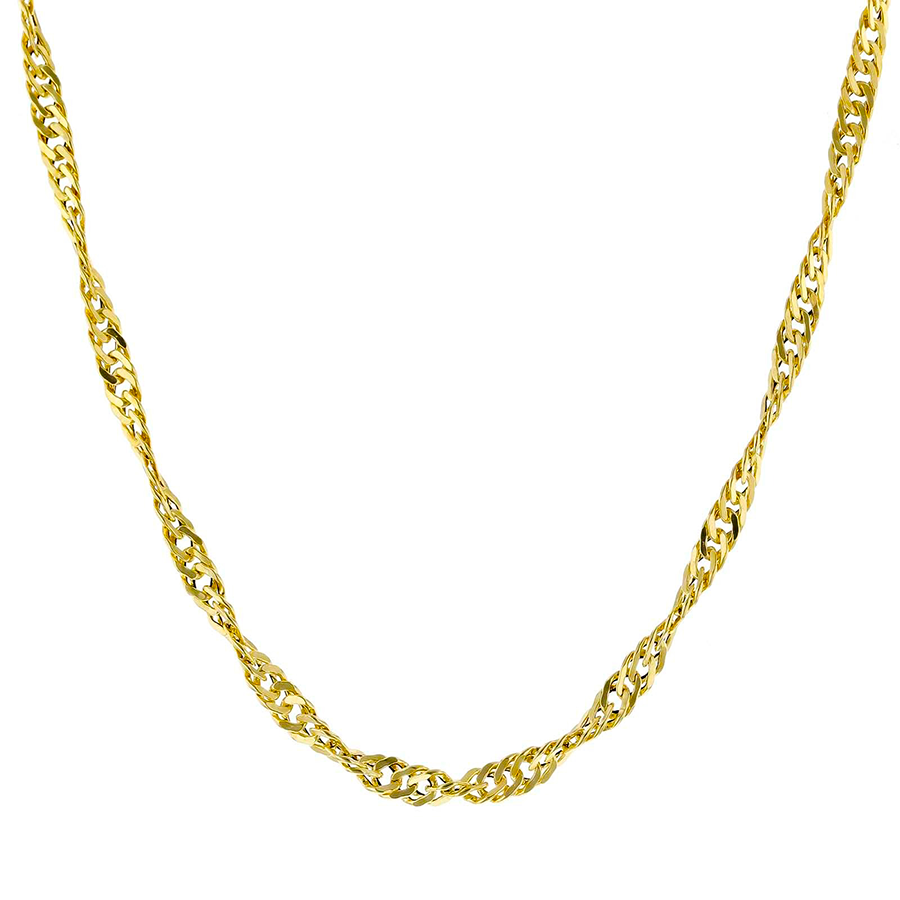
Singapore chain
Singapore is a sparkling hybrid of curb and rope chains made of a series of twisted diamond-cut links.
Byzantine chain
Byzantine is an ancient style with a complex structure knitted from intricately folded links. The chain usually has a round profile but can be flat or square.
Cardano aka Boston link
Cardano, aka Boston link chain, is a stylish string of smooth, elongated links resembling a Cardan joint named after the Italian mathematician Gerolamo Cardano.

Figaro chain
Figaro is named after the title character of “The Marriage of Figaro” opera. The chain alternates a longer link with several shorter ones. The Figarope or Milano is a twisted Figaro that gives it a woven appearance. The Figarucci is a variation of a Figaro chain with an anchor chain-style crossbar in the middle of the long link.
Bamboo chain
Bamboo chains resemble the Ball chain design but have hollow cylindrical links alternated with round beads.
Prince of Wales chain
Prince of Wales, also known as the Loose Rope, symbolizes the twisted nature of British royalty. It is more flexible than regular Rope because its links are not packed tight. Each rounded link is interconnected with four others.
San Marco chain
The San Marco chain consists of hollow rounded links flat on the back placed side by side at a 45-degree angle. It looks like a necklace made out of macaroni pasta from the top.
Crisscross chain
The Crisscross chain has a tight weave with petal-like links that resemble miniature paddles stamped from a shiny metal sheet. The ugliest chain in the whole world.
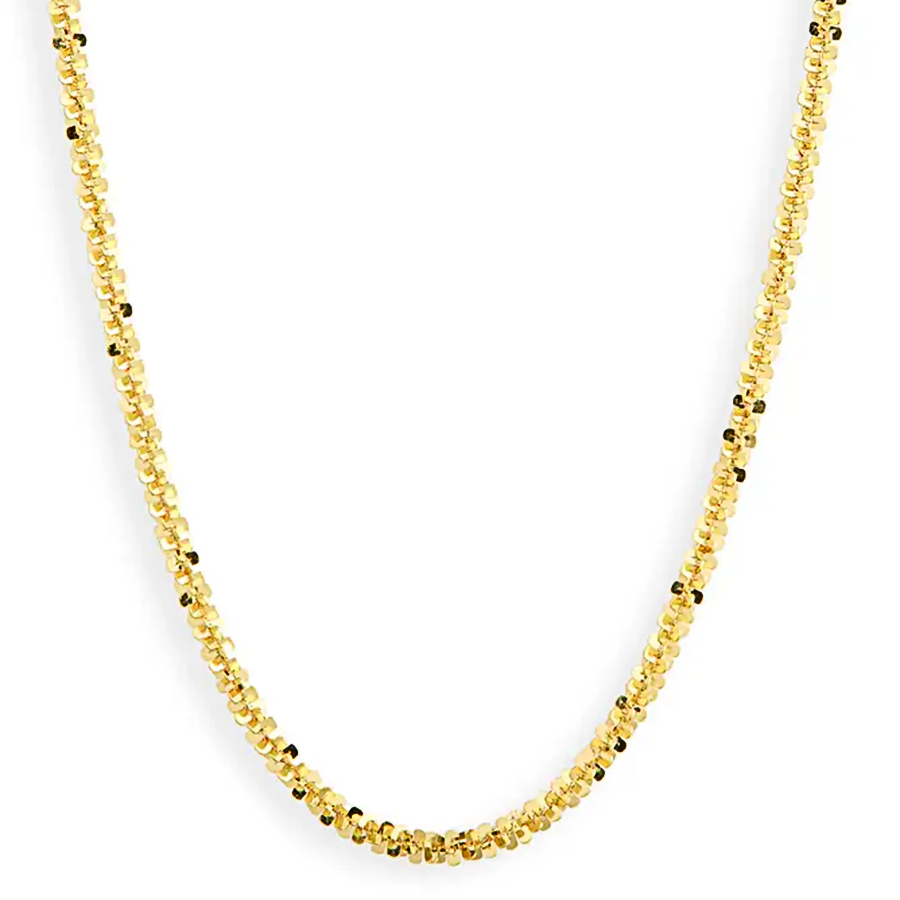
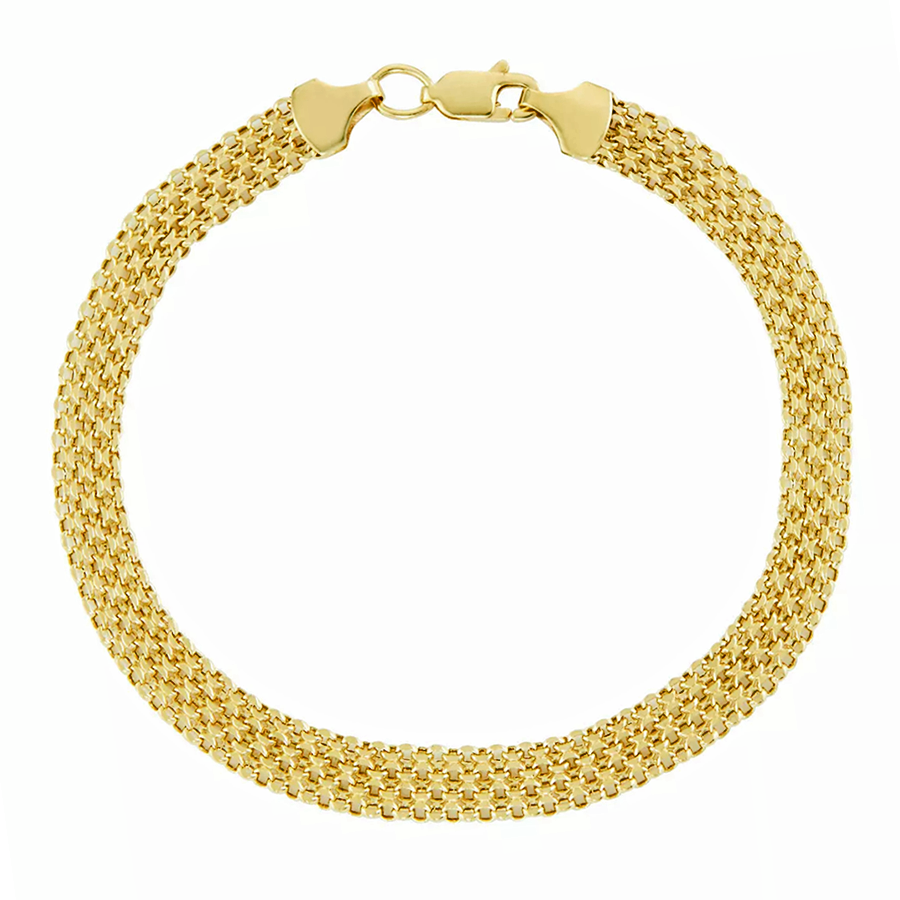
Bismark or Cascade chain
Bismark or Cascade chain, a perennial Russian favorite, has two or more interconnected round link chains running parallel next to each other.
Paperclip or Elongated link chain
An Elongated link chain has long links for a light and open look, a conversation piece in the office environment. It can be color-coordinated with a stapler. Cartier Santos-Dumont and Santos de Cartier are good examples of elongated link chains.
Railroad chain
The Railroad chain has two parallel strings with crossbars, making it look like a train track.
Bar link chain
A bar link chain comprises rods or bars connected via small jump rings. The bars can have any profile, usually round or square. They can be twisted or decorated with any finish imaginable.
Gourmette chain
The Gourmette chain is a braided curb chain with twisted links. This chain can vary in width from a few millimeters to a few centimeters. The Gourmette links are popular with men’s jewelry.
Rope chain
The Rope is a durable braided chain with a rigid, tightly-knit design suitable for gaudy pendants favored by some quarterbacks and hip-hop artists. The Rope has intertwined links forming two strands wrapped around each other, and it is considered the most durable chain design.
Nugget chain
The Nugget’s collapsed S-shaped links soldered, hammered, and twisted a quarter of a turn to make them look like a string of nuggets. It could also be any chain incorporating gold nuggets as its links.
Ladder or Hook chain
A simplistic design with two folded-back ends forms a hook extending to the next link.
Panther chain
The Panther is a flat chain of three or more rows of rectangular links offset by half a step from each other.
Box chain
A box chain comprises square links interlocked or joined with small jump rings. The size of the links and the distance between them can vary. It is a popular choice for necklaces, bracelets, and earrings because it is stylish and durable. The box chain is also known as the Venetian or square link chain. Box chain is a versatile and elegant chain that can be dressed up or down and is a popular choice for stacking with other chains. It is easy to care for.

What is the most durable chain?
The Rope is the most durable chain; its thickness is directly responsible for its strength. Thicker chains can withstand twisting and bending better. 14K gold or platinum chains are typically stronger than 18K or silver chains. Chain durability is not necessarily an advantage. A weak link is often left un-soldered to prevent choking if the chain is suddenly pulled.
A collar is an old term for a chain that typically lies flat to the body, for example, a Cuban link chain. Other types of chains are evenly weighted on all sides, for example, rope or box chains, so they hang freely.
Chain vs. Necklace
A necklace is set with gemstones, while chains are just metal. There is a grey area; for example, Elisa Peretti’s Diamonds By The Yard can be classified as a “chain” or a “necklace.”
- Choker is a short necklace resting on the collarbone
- Sautoir – very long necklace
- Riviera is a single strand of diamonds of either equal size or graduating down in size towards the back
- Festoon is a garland of flowers, ribbons, or leafs hung in a curve as a decorative element
- Fringe has a series of pendant elements that dangle from links or cords
- Collier or Collar necklaces are typically 12 to 13 inches long, laying flat on the body
- A pendant is a necklace or a chain with a jewel or medallion dropped from the center
- Lavalier or Negligee is a small-link, fairly long necklace terminating in a single large pendant or tassel
- Lariat necklaces don’t have a clasp. They either tied or pulled through an opening on the other end
- Bib or Plastron
- Opera is typically around 26 to 36 inches long
- Matinée is approximately 20 to 22 inches long
- Princess is typically 18 inches long
- The rope is over 30 inches long
Necklace length
- The Choker is 14-16” and sits snug around the neck.
- Princess is 16-18” long, falling to the mid-chest. Princess length is the preferred length for a pendant.
- Matinee extends to 20-22” in length.
- Opera drapes dramatically at 24-28”.
- The Rope or Lariat extends over 30”, covering the abdomen. As a double wrap, one turn is a choker, and the other is the Opera.
Diamonds-by-the-Yard: a chain or a necklace?
A string of small round diamonds wrapped in a channel wire and inserted at repeated intervals into a thin chain was popularized by Tiffany’s Elsa Peretti, who claimed the invention.
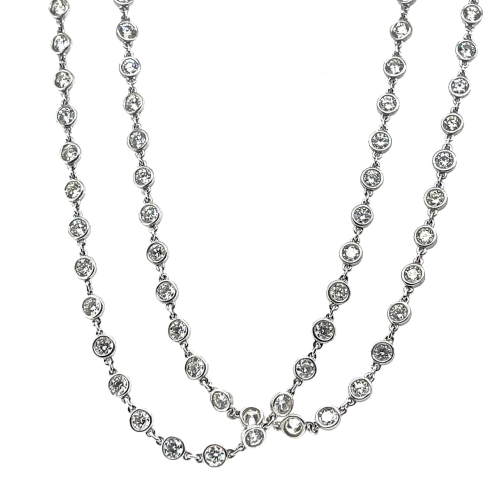
Necklace and chain clasps and closures
- Hook-and-Eye or S-Hook is the easiest and least secure clasp made of a hook that slips into an opening to keep the chain in place.
- Lobster Clasp is the most desirable and secure carabiner-style lock with a spring-loaded gate that snaps back in place once the cap end is inserted. It is opened by simply pulling a small lever that lifts the lip allowing the cap end to be released.
- Spring Ring is a simple, lightweight clasp made from a hollow tube with a spring inside. Pulling the lever opens the slot for a cap end to be inserted. Once the lever is released, the clasp locks the cap end.
- The alligator clasp is used as a traditional lock or as a clip for accessories. It features a large loop suitable for multi-strand designs, large cords, or leather strings.
- Ball-and-Joint clasps use pressure to keep the clasps closed. Their easy-open and easy-close design are too flimsy for expensive necklaces, so they are used mainly for lightweight chains.
- The Fishhook clasp has a fishhook-shaped tongue threaded inside a box where it clicks in place. Ideal for lightweight necklaces and bracelets.

